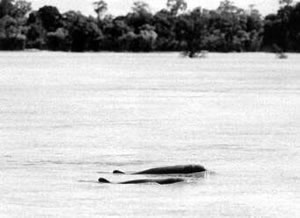Cambodia Dolphins in the MekongOctober 2001
A Remaining Paradise


Pooshoo! Pooshoo! It’s the breathing sound of river dolphins. The Mekong River from the Himalayas submerged a vast jungle in Cambodia. In this river many kinds of aquatic animals live. Judging from the frequency of the breathing sound, the number of river dolphins living here in Kratie Prefecture seemed to be three times as many as it was seven years ago. Ironically, in this undeveloped region because of the civil war, there was a paradise for river dolphins, an endangered species on the list of the Red Data Book.
To get to Kratie Prefecture, we went up the Mekong River about 200 km from Phnom Penh. It took us five hours odd by a rapid transit boat.
At a market with a vestige of the French-owned Indochinese period, people worry about that they are receiving fish less and less. They say, “Some species of fish have disappeared,” or “This year we got only small fish. Maybe there are no fish any more except small ones.
Poor haul and dolphins at a crisis
Sham Kuru, an assistant manager of Kratie branch office of the fishery bureau, pointed out that the wide use of nylon nets caused poor hauls, and because of the poor hauls people tended to use longer nets or nets of fine meshes to catch more fish, which resulted in indiscriminate fishing. He also said there were some groups that caught fish in illegal ways. They send an electric current or throw a grenade into the water, for instance, but the fishery bureau can do nothing but look on with folded arms because they have guns. The fishery bureau aims at setting up fishing cooperatives at 41 villages in the Mekong basin and prohibiting thoroughly fishing in the rainy season and fishing methods that lead to indiscriminate fishing.
The reason for river dolphins here to be in a critical situation is that the number of fish which river dolphins feed on is decreasing. But besides that, nylon nets or illegal fishing methods also take dolphins’ lives. The bodies of dead dolphins have proved this.
A young boatman and a “mermaid”

Sop Me (17), who works as a boatman on the outskirts of Kratie, told me a fable of river dolphin.
Long, long ago, there was a family of three in a village. They were poor, but a girl in the family was very beautiful. A deity saw her and fell in love with the girl at first sight. He transformed himself into a snake and came down to the earth. The girl’s father took the snake home. When they arrived at his house, the deity showed his real shape. He and the girl fell in love with each other and lived happily. But, soon the day of parting came. The deity disappeared, leaving a gold bar to them. The family became rich.
A farmer who had seen it took a snake home and made his daughter meet the snake, but it was just a big snake. The snake swallowed the farmer’s daughter up to her shoulders. The farmer asked his neighbors for help. They cut up the snake’s body with a butcher knife and rescued his daughter. But her body was completely covered with mucus.
She felt ashamed of herself and ran to the river to bathe, but she couldn’t get rid of the slimy mucus. She was totally at a loss and jumped into water with a metal bowl on her head, with which she had poured water over herself. Then she suddenly became a mermaid. She came up to the water surface and said to her parents who were waiting for her on the bank, “Don’t worry about me. I’ll go to the different world.” She dived into the water again.
Me said, “Being swallowed by a snake and covered with mucus seems real, and the shape of the dolphin’s head resembles a bowl.” He seems not to think it is a made-up story. The title of this story is “Pusao (=mermaid).” Actually river dolphins are called “mermaid” in Cambodia. We can only see the backs of river dolphins as they breathe, because they seldom jump and the water whose clarity is less than 10 cm veils underwater movements of river dolphins. I think that’s all the more so for this mystique to be kept.
Incidentally, there is a fable in Laos. It says that a newly-married couple, who were rafting down a river for a utopia, fell into the basin of a waterfall and died. But they were reborn. The man became a bird and the woman became a river dolphin. This story was called ‘Pakah (=dolphin).
River dolphins are gathering to a sanctuary
The HAB21, a volunteer group in Yokohama, held an international conference for river dolphins in Kratie City four years ago, and the delegate of the group, Keiichi Iwashige (54), built a conservation center for river dolphins in this city in June this year at his own expense. Sen Tana, a former chief of the fishery bureau, told of the response of the government to this support. “Prime Minister Hun Sen delivered his statement on conservation of river dolphins and gave a letter of thanks to the HAB21. We expect of ecotourism centering on river dolphins.”
One of the prospective sight spots for the ecotourism is the depths off the shore of Kanpi Village, which is about 20 minutes’ sail upstream from the place 15 km north away from Kratie City. Although there are nine inhabitable deep places for river dolphins in Mekong River within Cambodia territory, nearly 100 dolphins are gathering here. After the conference, the fishery bureau appeals to the fishermen to protect river dolphins and exercises control over illegal fishing-maybe the river dolphins know this. This place, safe and easy for river dolphins to live in, is becoming their sanctuary.
A British tourist Frederick said, “Human beings can exterminate an animal, but cannot do the opposite. Only God can do it.” The tourists to Kratie are less than 1% of those to Angkor Wat. Last year there were 770 tourists.
Note: The Japanese name for this species of river dolphins is Kawagondo of the Monddonlidae family; the English name is Irrawaddy Dolphin; the scientific name is orcaella brevirostris. They live in rivers, lakes and inshore areas, so that the lives of river dolphins are easily influenced directly or indirectly by human beings as compared with dolphins living in a vast expanse of ocean.
